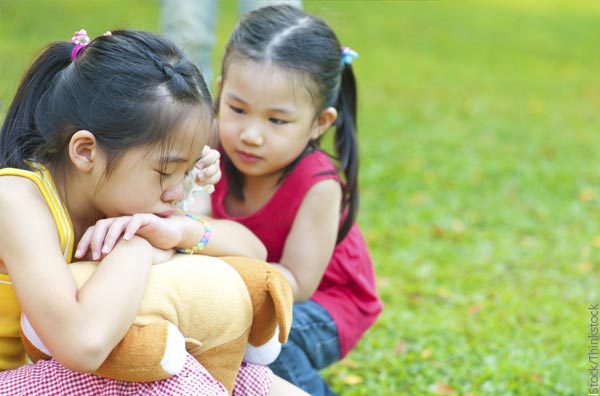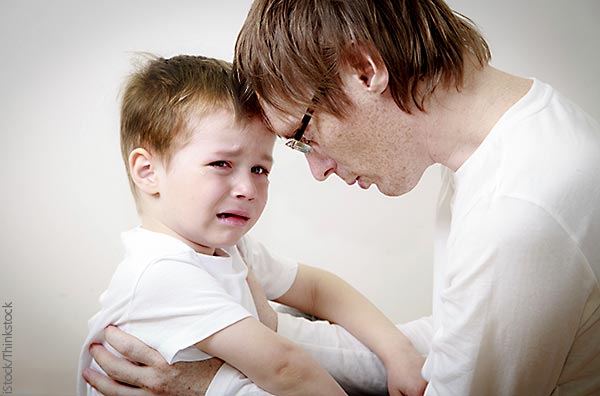Hitting, biting, spilling, pushing, yelling, and fighting, followed by scolding, correcting, apologizing, teaching, guiding—again and again. This pattern is one parents know all too well.
The pattern is simple. The child makes a mistake, acts out, does something she shouldn’t have, and the parent responds. Then minutes, hours, or days later, the child makes the same mistake—or a similar one—and the pattern repeats itself.
Why is this pattern so common, and why does a pattern that is seemingly so simple feel so complex? When an adult spills a drink, we might ask, “Are you okay?” or “What happened?” However, when a child spills a drink, the common response is: “Be careful!” or ‘Why did you do that? Watch out!”
The difference in responses has to do with the way in which children are perceived. We expect that with an adult, the mistake was an understandable one that may or may not have been his fault. However, with children, we often jump to the conclusion that if they had done something differently, the mistake would never have occurred.
It makes sense why, as adults, we respond this way. We see mistakes as intentional because sometimes they are: Children misstep to get our attention and to express frustration. Sometimes they act out intentionally; many times, they make a mistake because they are testing a boundary or trying to do things their way. This is important because, as we know, it is through trial and error that children learn.
These mistakes are challenging for a number of reasons. They may be a cause of concern when: (1) they involve issues related to safety, (2) the child makes the same mistake multiple times, and (3) the mistake causes an outcome that is difficult for the adult to manage. Ideally, these moments are opportunities to guide, teach, and learn something about who your child is—and who he is becoming. In fact, one way to monitor and seek greater progress is by asking some specific questions about the behavior to determine whether it was an honest mistake or an example of “acting out”:
- Was it intentional?
- What caused it?
- What impact did it have?
- How was it resolved?
- What could have prevented it?
- Is it happening more or less than before?
- What are the circumstances around the behavior (time of day, those involved, triggers for the behavior)?
The challenge for all parents is to respond instead of react. When we respond to children’s behavior, we help children develop a sense of remorse. Remorse comes from empathy, because as children understand how their behavior affected those around them, they begin to take ownership over it, which in turn leads to repair.
Children who can move from remorse to repair are more likely to build healthy attachments with others and be well received by the world, despite mistakes they make along the way. They are also more likely to avoid making the same mistakes more than once, because by connecting to the remorse they feel, they demonstrate that they understand why their behavior was problematic. They can then move toward offering a heartfelt apology, making amends, and seeking solutions that allow them to clean up the “wreckage.” By being a part of the solution, they are able to own the behavior while also moving away from the problem. This creates self-esteem that is based on the understanding that they have flaws but are not just their flaws.
On the other hand, when children are shamed, they begin to either “act out” or “act in.” They may identify as a victim, or be more likely to take on the role of offender. In addition, when children feel judged and criticized, they are more likely to become perfectionists. The focus on perfection is the child’s way of trying to gain back the control they feel they are lacking by striving to please those around them. They believe that if they are perfect, there will be no conflict and, therefore, no need to feel bad about who they are or what they have done.
The problem with this is that perfectionism does not allow for imperfection. Because perfection is unattainable, these children begin to believe that they are to blame when they can’t reach the high standards that they set for themselves. Oftentimes, these standards are also not developmentally appropriate. For example, if a 2-year-old tries to wash his parents’ car perfectly, he might not be able to do so because of his height, hand-eye coordination, etc.
In addition, perfectionism focuses on the product rather than the process. This is why many children who strive to be perfect to please others or to avoid feeling bad about themselves begin to reject activities that they don’t excel in, thereby limiting their opportunities for growth.
Guilt is what we feel when we have made an error. Shame, however, is what happens when we internalize this error. For example, we may feel guilty for what we have done, but if we say we are bad people because of it, then we move from owning a feeling related to an action or experience toward one that shapes our identity. This is dangerous, because in a world in which doing the right thing is the only way to feel accepted, or to receive love, children walk on eggshells and may turn into young adults who believe that a misstep can cause a collapse.
So what can we do to help children understand that feeling guilty is often appropriate but that shame is unnecessary?
- Show children that they can and should understand what is acceptable and unacceptable, appropriate and inappropriate. It is not only okay for them to feel these emotions, it is also beneficial. Guilt is not necessarily “bad.” However, we want to be cautious about where it takes us.
- Guilt allows for repair. What now? Ask your child to come up with solutions. Try to go outside the bounds of an apology.
- If you suggest to your child that he ask the person he hurt what he can do to help repair the damage, your child must consider the person’s pain and connect with him to find a way to make amends. This may involve sitting with the person who was hurt, which can prompt your child to shift his focus from himself to the injured party. By being in close proximity, he may experience that person’s pain. If you ask him to simply say “sorry,” he may believe it is okay to move on, even though the one who has been hurt is still hurting.
- Give it time. Often, our desire to rush children toward an apology or solution keeps them from going through their own essential process. Remind them that if they are not able to apologize in the moment, you will be waiting for them to do so when they are ready. By doing things on their time, they are more likely to offer an apology that is authentic and meaningful.
- Allow children to come up with ways to repair instead of instructing them in what should be done. You may elicit solutions by prompting questions, such as “What do you think that person may need to feel better?” or “What would you do differently if you could do it again?”
Remember that how you respond to your children affects how they feel about themselves. Your own shame becomes their own; your critical voice becomes their internal voice. Shame is passed along from one generation to the next, from sibling to sibling, and from what was said in a moment to how one feels about oneself over the course of a lifetime.
Ready for the good news? Just as shame can be internalized and carried internally over the course of a life, the same is true of positive sense of self and the ability to show remorse and repair. So begin today by acting instead of reacting, modeling instead of just teaching, and demonstrating that mistakes are natural and sometimes even beneficial.
Liana Unger, MSW, is Parents Place Coordinator in Santa Rosa.


